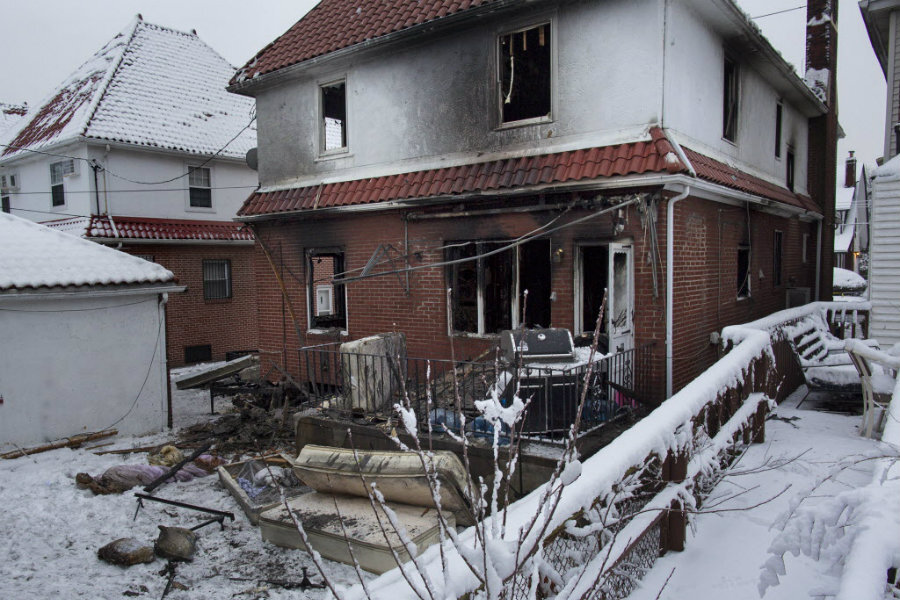Brooklyn house fire: How could it have been prevented?
Loading...
Seven children from a Jewish Orthodox family died in their Brooklyn, N.Y., home Saturday after a fire trapped the children – aged 5 to 15 – in their second-story bedrooms..
New York fire officials said the fire, which was the deadliest in New York City in eight years, was caused by a malfunctioning hot plate, often used by observant Jews to keep religious rules that forbid them from lighting fires on the Sabbath, The New York Times reported.
The incident highlights the need not only for increased awareness of fire safety practices in the home, but also for families and individuals to realize how important it is to be proactive in preventing those fires.
“We’re talking about [fire safety] a lot,” says Lorraine Carli, spokesperson for the National Fire Protection Association (NFPA). “But the challenge is getting people to take action.”
Every day, about seven people die and 36 are injured in house fires nationwide, according to the American Red Cross. In 2013 alone, about 85 percent of all fire deaths in the United States occurred in the home.
Once a fire starts, on average, people have only about two minutes to escape a burning house. But only 20 percent of Americans surveyed correctly answered how long it would take before a fire engulfed a home, according to a Red Cross survey. Part of the problem, Ms. Carli says, is that most people have a “general complacency about fire.”
Having working smoke alarms, for instance, is a simple yet oft-neglected step in fire safety. Both the NFPA and the Red Cross advocate fiercely for the installment of smoke alarms in every level of every home, which they calculate could cut by half the risk of dying in a fire.
Yet volunteers, during home-to-home awareness campaigns, often find that people will only put in one or two, says Joe Spaccarelli, a public affairs volunteer for the Greater New York/Long Island arm of the Red Cross.
Many who do have smoke alarms will forget to replace their batteries, rendering them useless, Mr. Spaccarelli adds.
Saturday’s fire in Brooklyn is a prime example: Investigators found evidence of only one smoke alarm, located in the basement, according to the New York City fire commissioner. No smoke detectors were found on the first and second floors. The bedrooms were located on the second floor.
“I can’t underscore enough the importance of smoke alarms in homes,” Carli says.
Other preventive measures are basic: Keep furniture, towels, and other flammable materials at least three feet away from space heaters and other types of heat sources. Don’t leave too many devices plugged into one outlet, a habit developed as a result of extension cords. Avoid smoking cigarettes in bed, and keep lighters and matches out of reach of children.
The kitchen can be an especially vulnerable area; two of every five home fires began in the kitchen, and unattended cooking was a factor in more than 30 percent of reported home fires caused by cooking, according to NFPA data. Stay in the kitchen when cooking, and make sure to turn off the burner when finished, the NFPA recommends.
Families should also talk about an escape plan in case a fire does occur in their home and practice evacuating at least twice a year, according to the Red Cross.
“A lot of people can’t think through that when it’s actually happening,” Saccarelli says. “That’s why preparedness is so important.”
He adds that being prepared for a fire – or for any disaster – is the responsibility of every person in every community: A malfunctioning hot plate used by an one family in Brooklyn could just as easily have been an unattended frying pan in some other part of the country.
Fire safety education is a constant task. The Red Cross, for instance, recently kicked off its Home Fire Preparedness Campaign, with the goal of reducing deaths and injuries by home fires by 25 percent over the next five years nationwide. The NFPA has held an annual Fire Prevention Week since 1922, reminding people to ensure their homes are fire safe.
The issue is to make sure that people internalize the message.
“We are constantly looking for ways to get that message out,” Carli says. "[But] people think it’s not going to happen to them.”






